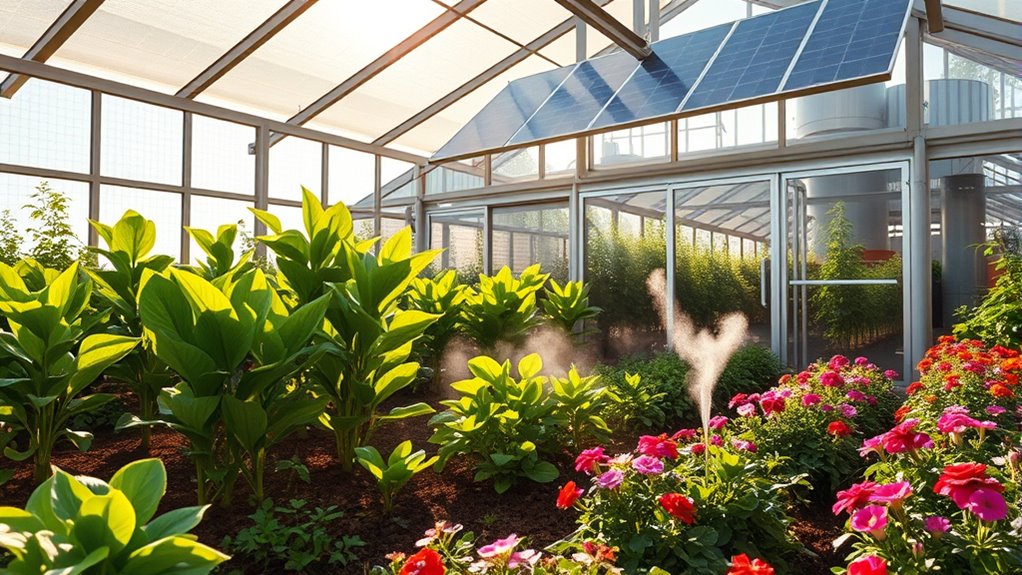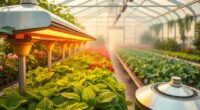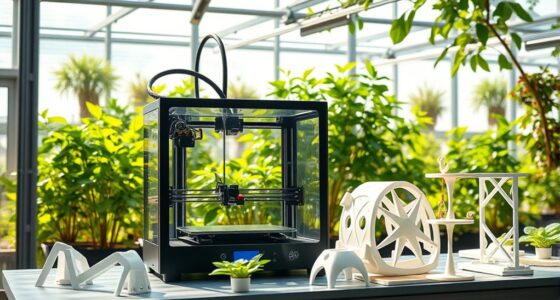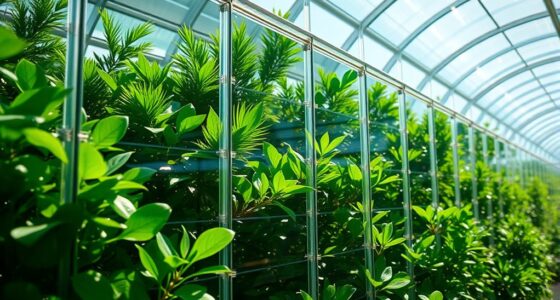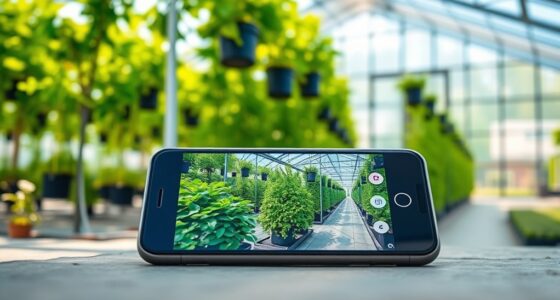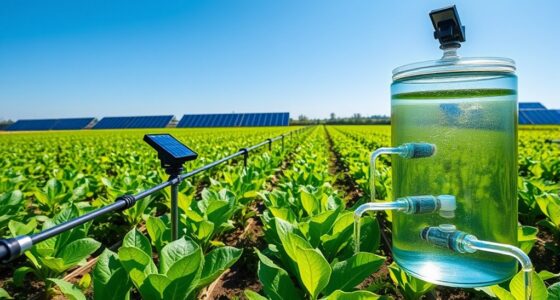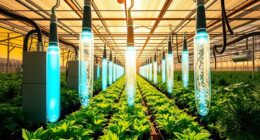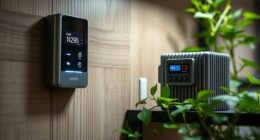Energy-efficient greenhouses harness solar power to create ideal growing conditions year-round. By using renewable energy, you reduce reliance on fossil fuels and lower operational costs. These greenhouses utilize advanced techniques like hydroponics, boosting crop yields and enhancing quality, regardless of the weather. With innovations in solar technology and passive designs, these structures improve sustainability. Want to discover more about their operation and benefits? There's plenty more to explore in the world of solar greenhouses!
Key Takeaways
- Solar-powered greenhouses utilize renewable energy, reducing reliance on fossil fuels and lowering operational costs for year-round gardening.
- Advanced growth techniques like hydroponics in solar greenhouses enhance crop yields and allow for sustainable urban agriculture.
- These structures are designed with thermal mass materials and passive solar systems, optimizing temperature control and energy efficiency throughout the year.
- Innovations, such as semi-transparent solar cells, increase energy generation without compromising plant growth, supporting sustainable agricultural practices.
- The integration of smart technologies and efficient materials further maximizes energy capture and minimizes water consumption in greenhouse operations.
Understanding Solar-Powered Greenhouses
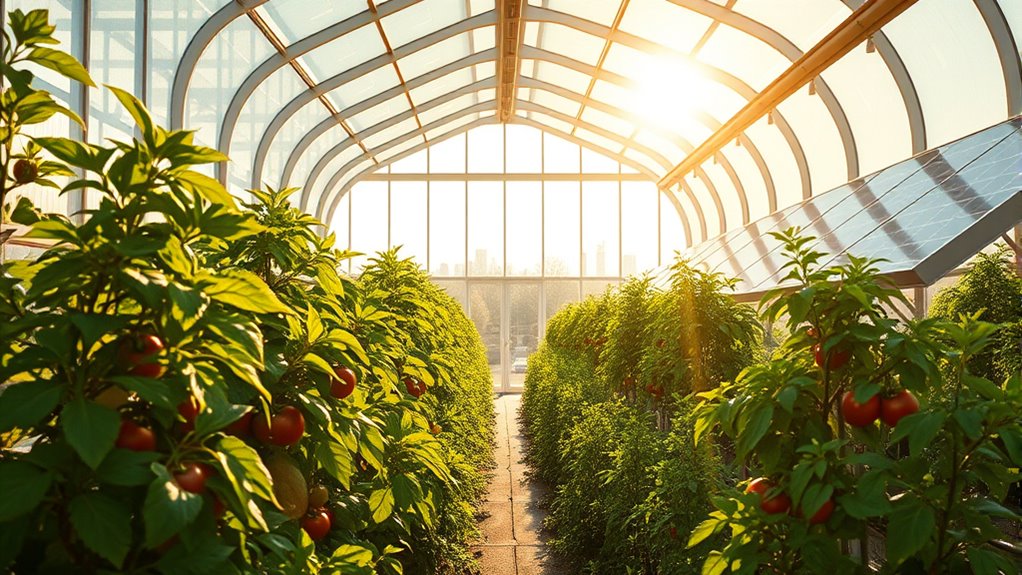
When you consider the future of sustainable farming, solar-powered greenhouses stand out as a game changer.
These innovative structures harness renewable energy, making them incredibly energy-efficient and less dependent on fossil fuels. By lowering operational costs, they promote sustainable agriculture while greatly reducing carbon footprints. Additionally, they can achieve higher yields through advanced growth techniques like hydroponics. In fact, many gardeners have reported substantial increases in productivity when utilizing energy-efficient systems in their designs. Moreover, like wood stoves, solar-powered greenhouses contribute to a greener home environment through efficient energy use. Incorporating nutrient-dense foods from your greenhouse can further enhance a sustainable lifestyle.
With the ability to maintain constant temperatures, these greenhouses allow you to grow crops year-round, maximizing your yield. Their design elements, like ideal orientation and insulation, further enhance energy absorption and heat retention.
Solar-powered greenhouses optimize energy use, enabling year-round crop growth and maximizing yields through clever design and insulation.
Plus, they minimize resource use, making them ideal for urban settings. Embracing solar-powered greenhouses not only supports your gardening goals but also contributes to a healthier planet and a more sustainable future.
How Solar Greenhouses Operate
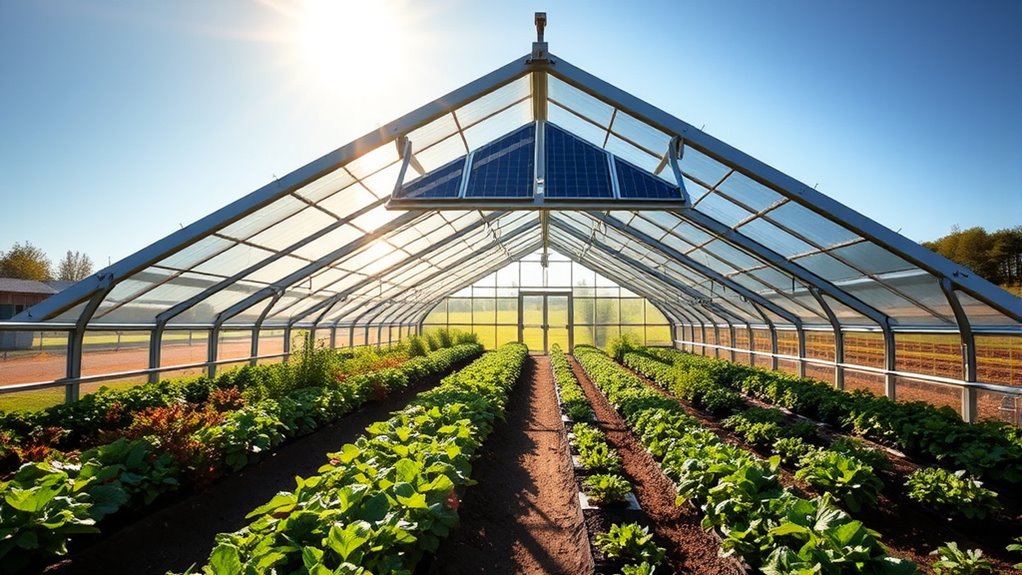
To maximize sunlight exposure and energy efficiency, solar greenhouses are typically oriented southward. They use materials like concrete or water as thermal mass, absorbing and storing heat for later use. The north side is well-insulated to prevent heat loss, especially in colder climates. Additionally, solar greenhouses are designed to utilize passive solar energy from the sun for heating, reducing reliance on traditional energy sources. Natural ventilation is key; vents and fans help regulate temperature, keeping the greenhouse cool in summer and warm in winter. Some designs even integrate solar panels, generating electricity for heating or cooling systems. Utilizing high light-transmittance materials on the south side enhances sunlight absorption, while strategically placed thermal mass optimizes heat storage. Furthermore, applying energy-efficient systems in heating can lead to a decrease in overall energy demand. Building a greenhouse with these features not only promotes sustainability but also provides a year-round growing environment. Moreover, incorporating cultural intelligence in designing greenhouses can enhance collaboration among diverse teams working on sustainable agricultural practices. Automated vents and sensors further improve temperature control, ensuring a productive environment for your plants throughout the year.
Key Benefits of Solar Greenhouses
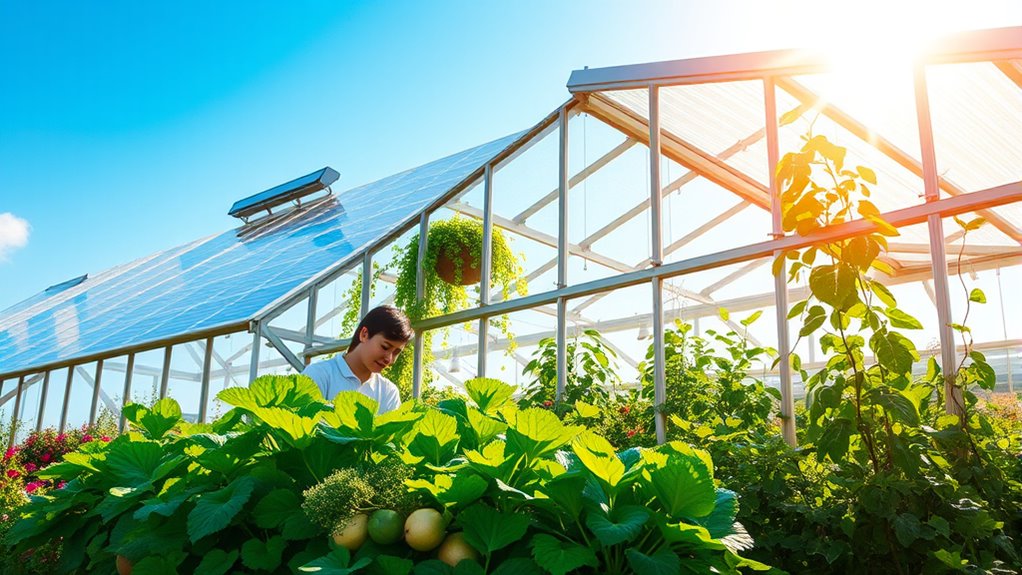
Solar greenhouses offer a multitude of benefits that extend beyond just energy efficiency.
First, they notably reduce your reliance on fossil fuels, leading to substantial long-term cost savings. By harnessing clean, renewable solar energy, you minimize your carbon footprint and contribute to a healthier environment. Additionally, these structures often feature optimal growing conditions, which further enhances plant growth and yields. Incorporating solar energy systems can further maximize efficiency and sustainability in your greenhouse. Furthermore, personalized learning pathways can be integrated into agricultural education, helping individuals understand the best practices for utilizing solar greenhouses effectively. Moreover, utilizing heat pumps in conjunction with solar energy can enhance temperature control, ensuring optimal growth throughout the seasons.
Plus, you can grow plants year-round, regardless of external weather conditions, which boosts your crop yields and quality. With lower operating costs and potential government incentives, your initial investment pays off over time.
You'll enjoy a self-sufficient lifestyle while engaging with your community in sustainable practices. Ultimately, solar greenhouses provide you with fresh produce throughout the year, enhancing both your diet and personal satisfaction.
Essential Components for Efficiency
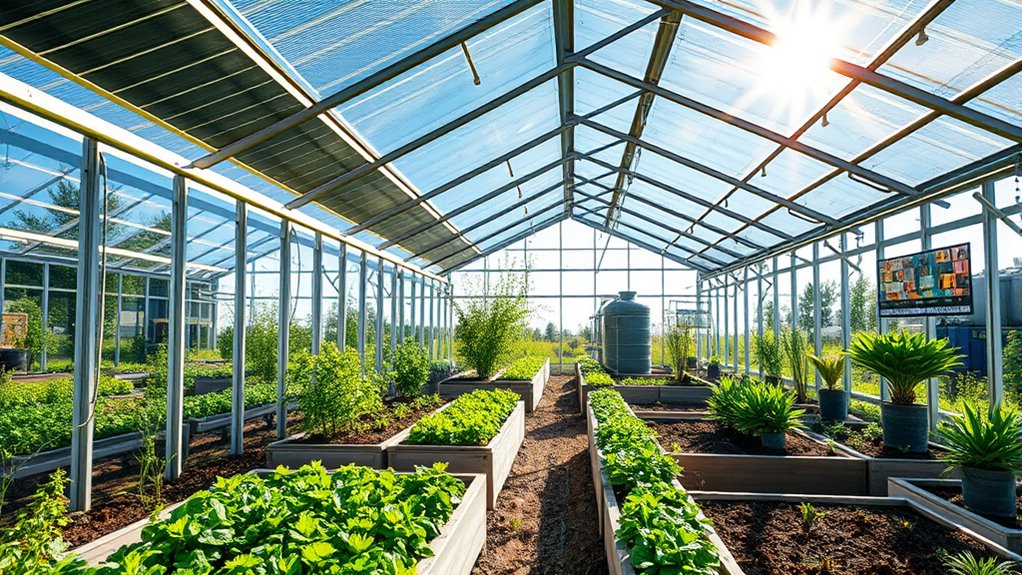
Creating an energy-efficient greenhouse requires careful attention to several essential components that work together harmoniously.
First, position your greenhouse to maximize sunlight, ideally facing south. Insulate non-south walls to retain heat and use thermal mass materials like stone or water to store warmth. Incorporate natural ventilation for cooling and automated climate control systems to optimize conditions. Additionally, implementing resource-efficient technologies is crucial for enhancing sustainability in greenhouse operations. Geothermal heat pumps, which offer energy savings of 30% to 70%, can be an excellent addition for efficient heating and cooling. Using solar panels for camping can also provide an eco-friendly source of energy for your greenhouse. Furthermore, consider integrating renewable energy sources to further reduce your carbon footprint and enhance energy efficiency.
Position your greenhouse to face south, insulate walls, and utilize natural ventilation for optimal climate control.
Integrate solar panels on the roof or nearby structures to harness solar energy for heating, cooling, and lighting. Consider battery storage for backup during low sunlight.
Utilize heat pumps and thermal energy storage systems for efficient temperature management. Finally, upgrade to LED lighting and implement automated systems to monitor and adjust environmental factors, ensuring your greenhouse remains efficient year-round.
Future Innovations in Solar Greenhouse Technology

As energy-efficient greenhouses evolve, exciting innovations in solar technology are paving the way for a greener future in agriculture.
Imagine integrating semi-transparent organic solar cells into your greenhouse; they generate power without hindering plant growth. These advanced materials allow you to enhance light absorption while achieving energy neutrality in warmer climates. This technology can provide energy needs reduced by 57% with its efficient design. Additionally, renewable energy technologies are forecasted to increase efficiency by over 40%, making them a vital component in sustainable agriculture. Smart toilets, for example, can contribute to water conservation efforts through their advanced flushing mechanisms and intelligent water level detection. Incorporating omega-3 sources like chia seeds into your gardening practices can also promote healthier plant growth.
With solar window technology, you can enjoy up to 57% less energy use and 29% less water consumption. Picture controlling your greenhouse's environment year-round, ensuring ideal conditions for your crops.
Passive solar designs and innovative materials help maximize energy capture and storage. By investing in these technologies, you're not just improving your gardening; you're contributing to sustainable practices that benefit both your wallet and the environment.
Frequently Asked Questions
What Crops Are Best Suited for Solar Greenhouses?
When considering crops for solar greenhouses, you'll find tomatoes, cucumbers, and peppers thrive well due to the controlled climate.
Basil and lettuce are also great choices, especially for spring and winter planting, respectively.
Additionally, leafy greens like kale and Swiss chard appreciate the stable environment.
Don't forget about root vegetables like carrots and beets, which can grow successfully year-round.
Each of these options maximizes the benefits of your solar greenhouse setup.
How Much Initial Investment Is Needed for a Solar Greenhouse?
When considering a solar greenhouse, you'll need to think about land acquisition, greenhouse structure, solar panel installation, and climate control systems.
Expect to invest anywhere from $50,000 for land and $5,000 to over $50,000 for the greenhouse.
Factor in additional costs for solar panels and climate controls, which can range from $1,000 to $10,000.
All these elements combine to create a significant initial investment, but the long-term benefits are worth it.
Can Solar Greenhouses Function in Colder Climates?
Yes, solar greenhouses can absolutely function in colder climates.
By carefully designing for insulation, orientation, and thermal mass, you can maximize heat retention and solar gain.
Utilizing materials that withstand harsh weather and implementing innovative systems like GAHT can enhance efficiency.
You'll not only extend your growing season but also cultivate a diverse range of crops year-round.
With the right approach, you can achieve sustainable gardening even in challenging conditions.
What Maintenance Is Required for Solar Panels in Greenhouses?
To maintain solar panels in your greenhouse, clean them at least once or twice a year, ideally in the morning or evening when they're cool.
Use a soft brush with a mild detergent to avoid damage.
Regularly inspect for shading from nearby trees and check the inverter for any error messages.
Track energy output to spot issues early, and consider scheduling annual professional inspections to guarantee everything's running smoothly.
Are There Grants Available for Building Solar-Powered Greenhouses?
Yes, there are grants available for building solar-powered greenhouses.
You should explore programs like the Solar for All initiative and the Greenhouse Gas Reduction Fund, which support renewable energy projects.
Many states also offer specific grants.
Make sure your project demonstrates environmental benefits and engages the community, as these factors can enhance your chances of securing funding.
Don't forget to check local non-profits that might assist with clean energy initiatives, too.
Conclusion
In a world where every drop of energy counts, solar-powered greenhouses offer you a chance to cultivate your garden year-round, much like the mythical phoenix rising from the ashes. By harnessing the sun's power, you're not just growing plants; you're nurturing a sustainable future. Embrace the benefits of these innovative structures, and watch as your gardening dreams flourish, turning your backyard into a vibrant oasis that thrives even in the coldest months.
